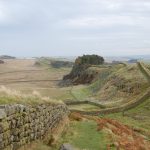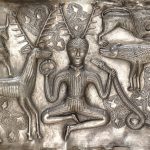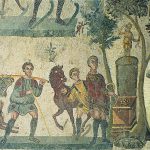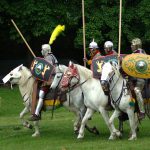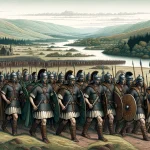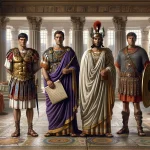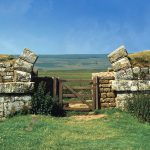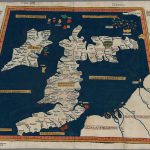Maryport (Alauna) Roman Fort
Hadrianic Auxiliary Fort (117 to 138)

The fort at Maryport formed part of the ‘Western Sea Defences’, a line of forts and watch-towers strung along the north-western coastline of Cumbria; a western extension of Hadrian’s Wall. The fort is considerably larger than that necessary to accommodate the units which have been attested here. This surplus area has suggested to some scholars that Maryport may have been the administrative centre for the whole of the Western Sea Defences, but this cannot be proven. A magnetometric survey conducted in 2000 revealed the outline of the principia or regimental headquarters building in the centre of the fort with a clearly defined strongroom in the building’s back range, while outside the defences a substantial vicus settlement was seen to extend for at least 330 yards (300m) along the road to the north-east (Britannia, 2001).
The site of the Maryport fort overlooking the Solway Estuary is certainly picturesque but the Roman remains are less than spectacular, especially when compared with the magnificence of sites such as Hardknott or Housesteads. The reconstruction of a Roman watch-tower in the grounds of the Senhouse Roman Museum did, however, offer a limited view of the fort’s defences with the civil settlement beyond.
During excavations over the years at the Maryport fort a number of mollusc shells have been uncovered, including those of Oyster, Mussel and Edible Snail. (See the article: The Roman Military Diet by R.W. Davies, in Britannia II (1971) pp.122-142).
Who Built Alauna (Maryport)?
The fort was built by legionaries from both the Second and Twentieth legions, very likely at sometime during the reign of the emperor Hadrian (see RIB 851 below).
RIB 852 - Building inscription of the detachments of the legio II Augusta and XX Valeria Victricix
Detachments of the Second Legion Augusta and of the Twentieth Legion Valeria Victrix built (this).
ET XX V V
FECERVNT
No commentary.
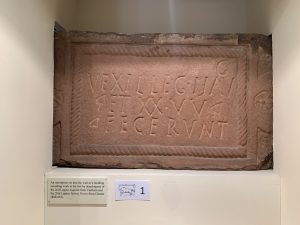
RIB 851 - Inscription dedicated to the Emperor Caesar Trajan Hadrian
For the Emperor Caesar Trajan Hadrian ..
[...]DṚ[... ...]
No commentary.
Building Inscriptions from the Second and Third Centuries
Some building work was undertaken by the auxiliary regiment Cohors I Hispanorum (RIB 855) and possibly by their successors Cohors I Delmatarum (RIB 850).
RIB 855 - Building Inscription of Cohors I Hispanorum
The First Cohort of Spaniards built (this).
[...]Ị[...]
[...]
No commentary.
RIB 850 - Dedication to Antoninus Pius
For the welfare of the Emperor Caesar Antoninus Augustus Pius, father of his country, Paulus Postumius Acilianus, son of Paulus, of the Palatine voting-tribe, prefect of the First Cohort of Dalmatians (set this up).
ANTONIN[...] AVG PII P [...]
[...]AVLVS [...] F PALATINA
[... ]VS ACIL[...]ANVS
PRAEF C[...]H I DELMATAR
For Acilianus see RIB 810, 832, 833, 847.
There was another spate of building in the middle of the third-century, this time by detachments from the Twentieth Legion (RIB 854).
RIB 854 - Building Inscription by Twentieth Legion Gordiana
The Twentieth Legion Gordiana (built this).
Gordiana was an honorific title, of a short-lived Roman dynasty, was employed from 238 to 244AD.
The Alauna (Maryport) Garrison Units
Cohors Primae Hispanorum – The First Spanish Cohort
The most frequently attested unit at Maryport – and probably the first to occupy the fort – was Cohors I Hispanorum Equitata, a five-hundred strong part-mounted unit recruited from amongst the tribes of the Roman Spanish provinces. The Notitia Dignitatum indicates that by the turn of the fifth century, the unit had been moved on to Vxelodvnvm (Stanwix, Cumbria). Of the twenty-three altars to Jupiter found at Maryport, ten are inscribed with the name of this regiment and a further six were dedicated by men known to have commanded the unit, which likely indicates that they were stationed here for a substantial period.
RIB 814 - Altar dedicated to Jupiter Augustus
To Jupiter Augustus Marcus Censorius Cornelianus, son of Marcus, of the Voltinian voting-tribe, centurion of the Tenth Legion Fretensis, acting-commander of the First Cohort of Spaniards, one thousand strong (?), from Nemausus in the province of Narbonese Gaul, willingly and deservedly fulfilled his vow.
M CENSORIVS
M FIL VOLTINIA
[...]ORNELIANVS 𐆛 LEG
[ ...]ETENSIS PRAE
[...]TVS COH I
HISP EX PROVINCIA
NARBONE[...] DOMO
NEMAVSO [...] S L M
Nemauso: Nîmes.
RIB 823 - Altar dedicated to Jupiter Optimus Maximus by the Tribune Marcus Maenius Agrippa
To Jupiter, Best and Greatest, the First Cohort of Spaniards, which is commanded by Marcus Maenius Agrippa, tribune, set this up.
COH I HIS
CVI PRAE
M MAENI
VS AGRIP
TRIBV
POS
This man was later to become Prefect in command of the British Fleet, the Classis Britannica (CIL xi.5632).
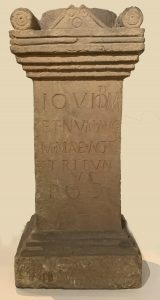
RIB 816 - Altar dedicated to Jupiter Optimus Maximus
To Jupiter, Best and Greatest, the First Cohort of Spaniards, part-mounted, which is commanded by its prefect, Lucius Antistius Lupus Verianus, son of Lucius, of the Quirine voting-tribe from Sicca in Africa, (set this up).
COH I HISP
EQ CVI PRAEEST
L ANTISTIVS L F
QVIRINA LVPVS
VERIANVS PRAEF
DOMV SIC
CA EX AFRICA
Sicca Veneria, a colonia in Numidia Proconsularis.
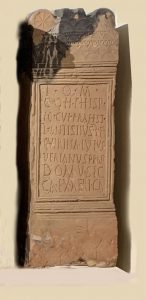
Cohors Primae Delmatarum – The First Cohort of Dalmatae
The second auxiliary unit identified at Maryport was Cohors I Delmatarum, a five-hundred strong infantry unit of Delmatae tribesmen from the Adriatic coast of modern Croatia. This regiment is attested on a number of inscriptions, two of them being positively dated to the reign of Antoninus Pius in the period 138-61AD.
RIB 832 - Altar dedicated to Jupiter Optimus Maximus Capitolinus
To Jupiter, Best, Greatest, Capitolinus, for the welfare of Antoninus Augustus Pius, Postumius Acilianus, prefect of the First Cohort of Dalmatians, (set this up).
CAPITOLINO
PRO SALVT AN
TONINI AVG
PII POSTVMI
VS ACILIANVS
PRAEF COH I DELM
For Postumius Acilianus see RIB 810, 833, 847, 850.This thin slab presumably had been built into a structure intended to carry or contain the dedications associated with the parade-ground, possibly a platform (tribunal).
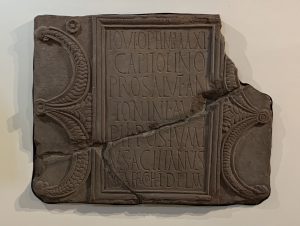
RIB 850 - Dedication to Antoninus Pius
For the welfare of the Emperor Caesar Antoninus Augustus Pius, father of his country, Paulus Postumius Acilianus, son of Paulus, of the Palatine voting-tribe, prefect of the First Cohort of Dalmatians (set this up).
ANTONIN[...] AVG PII P [...]
[...]AVLVS [...] F PALATINA
[... ]VS ACIL[...]ANVS
PRAEF C[...]H I DELMATAR
For Acilianus see RIB 810, 832, 833, 847.
Cohors Primae Baetasiorum Civium Romanorum – The First Cohort of Baetasii, Citizens of Rome
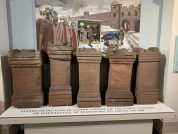
Another auxiliary regiment which occupied the Maryport fort was Cohors I Baetasiorum, a five-hundred strong infantry unit of the Baetasii tribe from the area to the immediate west of Novaesium in Germania Inferior (Neuss, Westfalen, West Germany). This unit was originally stationed at the Bar Hill fort in the middle of the Antonine Wall, and moved to Maryport during the late Antonine period. The experience gained in the maritime environment here on the Cumbrian coast was later to see the unit posted to the Saxon-Shore fort at Regulbium (Reculver, Kent).
RIB 838 - Altar dedicated to Military Mars
To Military Mars the First Cohort of Baetasians, Roman citizens, which is commanded by Ulpius Titianus, its prefect, gladly, willingly, and deservedly fulfilled its vow.
COH I BAETASIO
RVM C R
CVI PRAEEST V[...]
PIVS TITIANV[...]
PRAEF V S L L M
For Ulpius Titianus cf. RIB 843.
RIB 830 - Altar dedicated to Jupiter Optimus Maximus
To Jupiter, Best and Greatest, the First Cohort of Baetasians, Roman citizens, which is commanded by Titus Attius Tutor, prefect, willingly, gladly, and deservedly fulfilled its vow.
COH I BAETA
SIORVM
C R CVI PRAE
EST T ATTIVS
TVTOR PRAEF
V S L L M
For T. Attius Tutor see RIB 837, 842. For his later career see CIL iii 5331 (ILS 2734).
Altars Dedicated to Jupiter at Alauna (Maryport)
The usual place you would expect to find altars dedicated to Jupiter was in the principia or regimental headquarters building in the centre of the fort, but at Alauna no less than twenty-three altar-stones dedicated to the god Jupiter Best and Greatest were found buried at regular intervals beneath the parade-ground outside the camp. It is thought that there was only one active altar to Jupiter Optimus Maximus beside the parade-ground at any given moment, and a new one was perhaps dedicated by the unit commander each year, at which time the old altar was ceremoniously buried beneath the parade-ground so as to prevent desecration. This procedure possibly took place on the 3rd January, when the troops renewed their ‘Oath of allegiance’ to the emperor and state.
Other Gods Attested in Alauna (Maryport)
To the Genius of this place, Fortune the Homebringer, Eternal Rome, and Good Fate,
Gaius Cornelius Peregrinus, Tribune of the Cohort, Decurion of his home town of Saldae
in the province of Mauretania Caesariensis,² gladly, willingly and deservedly fulfilled his vow.
Saldae, a colonia near modern Bejaia, Northern Algeria.
RIB 808 - Dedication to Asclepius
‘To Asclepius,¹ Aulus Egnatius Pastor² set this up.’
Ασκλεπιος = Æsculapius, the god of medicine, a son of Apollo.
The dedicator has the three names indicative of Roman citizenship but no official titles, either military or magisterial, which suggests that he was a privatus or civilian, quite possibly a physician.
RIB 846 - Altar dedicated to Volcanus
Helstrius Novellus, prefect, set this up to the divine power of Volcanus.
VS NOVEL
LVS PRAE
FECTVS
NVMINI
VOLCAN[...]
[...]O[...]
Helstrius Novellus, praef. coh. I Hispanorum
RIB 809 - Altar dedicated to Belatucadrus
To Belatucadrus Julius Civilis, optio, willingly and deservedly fulfilled his vow.
CADRO
IVL CI
VILIS
OPT
V S L M
Belatucadrus was an iron-age war god, often associated with Mars. An optio was an orderly or non-commissioned officer whose duties were primarily administrative. They were assigned one per century and ranked junior to the centurion.An optio was an under-officer to a centurion, his second-in-command.
More Tombstones from Alauna (Maryport)
RIB 859 - Funerary inscription for Vireius Pau[...
To the spirits of the departed (and) of Vireius Pau[..
MANIBV[...]
VIREI PAV[...]
No commentary.
RIB 860 - Funerary inscription for Ingenuus
To the spirits of the departed (and) of Ingenuus, aged 10 Julius Simplex, his father, had this set up.
INGENVI AN X
IVL SIMPLEX PATER
F C
No commentary.
RIB 862 - Funerary inscription for Rianorix
Rianorix lived … years.
ANNOS [4]
No commentary.
RIB 863 - Funerary inscription for Spurcio
Spurcio lived 61 years.
No commentary.
RIB 867 - Funerary inscription for Luca
To the spirits of the departed Luca lived 20 years.
LVCA VIX
ANN
IS XX
The gender of the name Luca is uncertain R.P.W.
Classical References for Alauna (Maryport)
Not listed in Ptolemy’s Geography, the Antonine Itinerary or the Notitia Dignitatum, the only classical geographical source for the name of the Roman fort and settlement at Maryport is an entry in the The Ravenna Cosmography (R&C#118). The station Alauna appears in this document between Gabrosentum (Moresby, Cumbria) and Bibra (Beckfoot, Cumbria). The modern town was founded in the late eighteenth century and named Mary Port, after the wife of the landowner and industrialist Humphrey Senhouse who built the harbour here in 1762.
The Meaning of the name Alauna?
Alauna is one of the commonest ancient names in Britain and on the Continent. It appears to be an adjective that served primarily as a river name, applied secondarily to forts and settlements near the mouths of those rivers, and to people and gods from there.
It is possible that the Roman name for the fort and settlement at Maryport is derived from a word (Welsh/Gaelic) which described its location, perhaps meaning ‘beautiful, wonderful’ (q.v. Gaelic alainn(e) ‘elegant, beautiful, splendid’). A plausible alternative, given the many altarstones found on the site, is that the name may be derived from a word (Welsh/Gaelic) for ‘shrine’ or ‘altar’ (q.v. Welsh allor (plural allorau) ‘altar(s)’).
The suffix Carvetiorum was used on this site to distinguish this particular site from others, also named Alauna in Roman times, and qualifies this town as belonging to the tribal lands of the Carvetii . The Romans would have just used the name Alavna.
References for Alavna [carvetiorvm]
- The Archaeology of Roman Britain by R.G. Collingwood (Methuen, London, 1930);
- The Roman Inscriptions of Britain – Vol.1 – Inscriptions on Stone by R.G. Collingwood and R.P. Wright (Oxford 1965);
- Temples in Roman Britain by M.J.T. Lewis (Cambridge 1966); Chronology of the Ancient World by E.J. Bickerman (Thames & Hudson, London, 1980);
- Chronicle of the Roman Emperors by Chris Scarre (Thames & Hudson, London, 1995); Britannia xxxii (2001) pp.337-9 & fig.13 p.338;
Map References for Alavna [carvetiorvm]
NGRef: NY 038 372 OSMap: LR89
Roman Roads near Alavna [carvetiorvm]
Military road: NNE (7.5) to Beckfoot (Beckfoot, Cumbria) military road: SSW (5) to Bvrrow Walls (Burrow Walls, Cumbria) Possible Road: ENE (15) to Old Carlisle (Maglona) (Old Carlisle, Cumbria) SE (6) to Papcastle (Papcastle, Cumbria)
Sites near Maryport (Alauna) Roman Fort
- Maryport (Alavna) Vicus (0 km)
Vicus - Maryport Temples (0 km)
Temple Or Shrine - Western Sea Defences - Milefortlet 21 - Swarthy Hill (4 km)
Western Sea Defences - Burrow Walls (Magis) Roman Fort (8 km)
Western Sea Defences - Papcastle (Derventio) Roman Fort (9 km)
Flavian Auxiliary Fort (AD 69–96) - Papcastle (Derventio) Vicus (9 km)
Vicus - Beckfoot (Bibra) Roman Fort (13 km)
Western Sea Defences - Blennerhasset Roman Fort (16 km)
Flavian Auxiliary Fort (AD 69–96) - Caermote Roman Fort (16 km)
Trajanic Auxiliary Fort (A.D. 98–117) - Parton (Gabrosentum) Roman Fort (17 km)
Hadrianic Auxiliary Fort (117 to 138)
